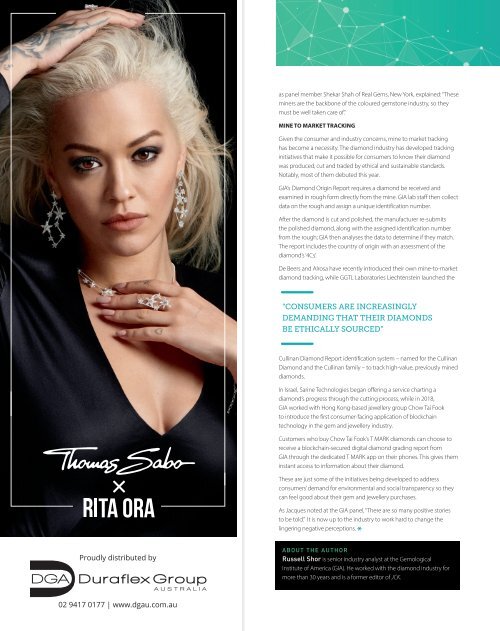Jeweller: The Great Diamond Debate - Round II
Facts Vs Marketing: In 2019, both natural and man-made diamonds battled for the hearts and minds of consumers – and the gloves came off. While the dust is far from settled, the question remains: can consumers really make an informed choice in the midst of a marketing barrage and an increasingly confused industry?
Facts Vs Marketing: In 2019, both natural and man-made diamonds battled for the hearts and minds of consumers – and the gloves came off. While the dust is far from settled, the question remains: can consumers really make an informed choice in the midst of a marketing barrage and an increasingly confused industry?
You also want an ePaper? Increase the reach of your titles
YUMPU automatically turns print PDFs into web optimized ePapers that Google loves.
as panel member Shekar Shah of Real Gems, New York, explained: “<strong>The</strong>se<br />
miners are the backbone of the coloured gemstone industry, so they<br />
must be well taken care of.”<br />
MINE TO MARKET TRACKING<br />
Given the consumer and industry concerns, mine to market tracking<br />
has become a necessity. <strong>The</strong> diamond industry has developed tracking<br />
initiatives that make it possible for consumers to know their diamond<br />
was produced, cut and traded by ethical and sustainable standards.<br />
Notably, most of them debuted this year.<br />
GIA’s <strong>Diamond</strong> Origin Report requires a diamond be received and<br />
examined in rough form directly from the mine. GIA lab staff then collect<br />
data on the rough and assign a unique identification number.<br />
After the diamond is cut and polished, the manufacturer re-submits<br />
the polished diamond, along with the assigned identification number<br />
from the rough; GIA then analyses the data to determine if they match.<br />
<strong>The</strong> report includes the country of origin with an assessment of the<br />
diamond’s ‘4Cs’.<br />
De Beers and Alrosa have recently introduced their own mine-to-market<br />
diamond tracking, while GGTL Laboratories Liechtenstein launched the<br />
“CONSUMERS ARE INCREASINGLY<br />
DEMANDING THAT THEIR DIAMONDS<br />
BE ETHICALLY SOURCED”<br />
Cullinan <strong>Diamond</strong> Report identification system – named for the Cullinan<br />
<strong>Diamond</strong> and the Cullinan family – to track high-value, previously mined<br />
diamonds.<br />
In Israel, Sarine Technologies began offering a service charting a<br />
diamond’s progress through the cutting process, while in 2018,<br />
GIA worked with Hong Kong-based jewellery group Chow Tai Fook<br />
to introduce the first consumer-facing application of blockchain<br />
technology in the gem and jewellery industry.<br />
Customers who buy Chow Tai Fook’s T MARK diamonds can choose to<br />
receive a blockchain-secured digital diamond grading report from<br />
GIA through the dedicated T MARK app on their phones. This gives them<br />
instant access to information about their diamond.<br />
<strong>The</strong>se are just some of the initiatives being developed to address<br />
consumers’ demand for environmental and social transparency so they<br />
can feel good about their gem and jewellery purchases.<br />
As Jacques noted at the GIA panel, “<strong>The</strong>re are so many positive stories<br />
to be told.” It is now up to the industry to work hard to change the<br />
lingering negative perceptions. i<br />
Proudly distributed by<br />
ABOUT THE AUTHOR<br />
Russell Shor is senior industry analyst at the Gemological<br />
Institute of America (GIA). He worked with the diamond industry for<br />
more than 30 years and is a former editor of JCK.<br />
02 9417 0177 | www.dgau.com.au


















